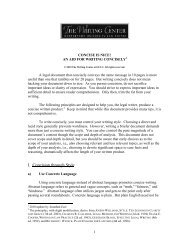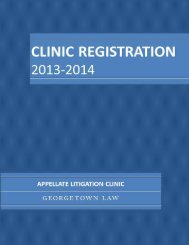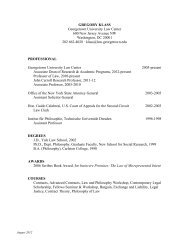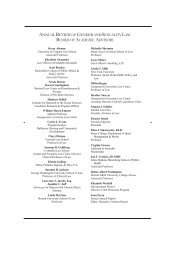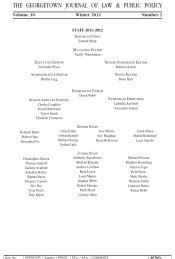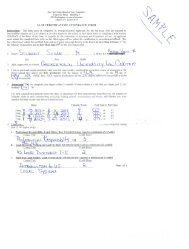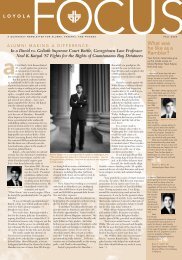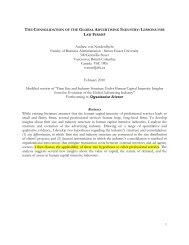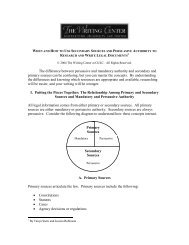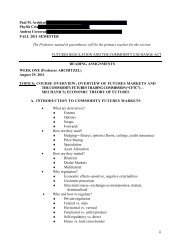Date: April 12, 2013 Topic: The Shrinking ... - Georgetown Law
Date: April 12, 2013 Topic: The Shrinking ... - Georgetown Law
Date: April 12, 2013 Topic: The Shrinking ... - Georgetown Law
You also want an ePaper? Increase the reach of your titles
YUMPU automatically turns print PDFs into web optimized ePapers that Google loves.
REFERENCES<br />
Alavi, M., Leidner, D. E. (2001). Review: Knowledge management and knowledge management<br />
systems: Conceptual foundations and research issues. MIS Quarterly , 25(1):107-136.<br />
Cohen, A. 2011. <strong>The</strong> 2011 <strong>Law</strong> Firm Technology Survey. <strong>The</strong> American <strong>Law</strong>yer, November.<br />
Aydin, C., R. E. Rice. 1992. Bringing social worlds together: Computers as catalysts for new<br />
interactions in health care organizations. J. Health Soc. Behav. 33 168–185.<br />
Barley, S.R. (1986). Technology as an occasion for structuring: Evidence from observation of<br />
CT scanners and the social order of radiology departments. Administrative Science Quarterly,<br />
31, 78–108.<br />
Barley, S.R. (1988). Technology, power, and the social organization of work. Research in the<br />
Sociology of Organizations, 6, 33–80.<br />
Barley, S.R. (1990). <strong>The</strong> alignment of technology and structure through roles and networks.<br />
Administrative Science Quarterly, 35, 1–8.<br />
Braverman, H. 1974. Labour and Monopoly Capital: <strong>The</strong> Degradation of Work in the Twentieth<br />
Century. New York & London: Monthly Review Press.<br />
Briscoe, F. and W. Tsai. 2011. “Overcoming Relational Inertia: How Organizational Members<br />
Respond to Acquisition Events in a <strong>Law</strong> Firm.” Administrative Science Quarterly 56(3): 408-<br />
440.<br />
Burkhardt, M.E., and Brass, D.J. (1990). Changing patterns or patterns of change: <strong>The</strong> effects of<br />
a change in technology on social network structure and power. Administrative Science<br />
Quarterly, 35, 104–<strong>12</strong>7.<br />
Haas, M. and M. Hansen. 2007. When Using Knowledge Can Hurt Performance: <strong>The</strong> Value Of<br />
Organizational Capabilities In A Management Consulting Company. Strategic Management<br />
Journal 26: 1-24.<br />
Hansen, M. T. 1999. <strong>The</strong> search-transfer problem: <strong>The</strong> role of weak ties in sharing knowledge<br />
across organizational subunits. Administrative Science Quarterly, 44: 82-111.<br />
Leonard-Barton, D. (1988). Implementation as mutual adaptation of technology and organization.<br />
Research Policy, 17(5), 251–267.<br />
Leonardi, P. 2007. Activating the Informational Capabilities of Information Technology for<br />
Organizational Change. Organization Science 18(5): 813-831.<br />
Lucas, H. 1975. Why information systems fail. New York: Columbia University Press.<br />
Orlikowski, W., & Barley, S. (2001). Technology and institutions: What can research on<br />
information tech nology and research on organizations learn from each other? MIS Quarterly,<br />
25, 145-165<br />
Orlikowski, W.J. (2000). Using technology and constituting structures. Organization Science.<br />
11(4), 404–428.<br />
Reagans R., and B. McEvily. 2003 ‘‘Network structure and knowledge transfer: <strong>The</strong> effects of<br />
cohesion and range.’’ Administrative Science Quarterly, 48: 240–268.<br />
Rice, R. E. 1987. Computer-mediated communication and organizational innovation. J. Comm.<br />
37 65–94.<br />
Rice, R.E., & Aydin, C. (1991). Attitudes toward new organizational technology: Network<br />
proximity as a mechanism for social information processing. Administrative Science<br />
Quarterly, 36, 219–244.<br />
<br />
<strong>12</strong>



